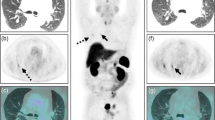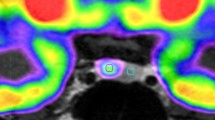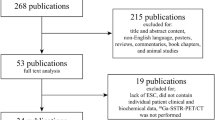Abstract
The role of 18F-Flurodeoxyglucose positron emission tomography (18F-FDG PET) scan in localization of ectopic Cushing’s syndrome (EAS) tumor is still controversial. Here, we report on the use of integrated 18F-FDG PET and computed tomography (18F-FDG PET/CT) in localization of EAS tumors in patients with ectopic Cushing’s syndrome. Five patients, three men and two women, were reported, whose endocrine investigations and negative pituitary imaging were suggestive of ectopic ACTH secretion. 18F-FDG PET/CT was performed to identify the source of ACTH secretion. Then the patients were suggested to perform pathologic examination. It turned out that all of these five patients have abnormal markedly intense FDG uptake lesions on 18F-FDG PET/CT images. Four of them underwent lesion resection, whose plasma ACTH and serum cortisol levels returned to normal after the surgery. Also, they were at last remission from all the symptoms. Pathologic results showed one thymic carcinoid, one pulmonary carcinoid, one thymoma, and one pulmonary carcinoid with upper mediastinum carcinoid. Unfortunately, one patient died due to severe infection and electrolyte disorders. 18F-FDG PET/CT technology integrates PET and CT imaging in one device so as to increase the accuracy of tumor localization and further improve the prognosis of the patients by curative resection.





Similar content being viewed by others
References
A.M. Isidori, G.A. Kaltsas, S. Mohammed, D.G. Morris, P. Jenkins, S.L. Chew et al., Discriminatory value of the low-dose dexamethasone suppression test in establishing the diagnosis and differential diagnosis of Cushing’s syndrome. J. Clin. Endocrinol. Metab. 88, 5299–5306 (2003)
A.M. Isidori, G.A. Kaltsas, C. Pozza, V. Frajese, J. Newell-Price, R.H. Reznek et al., The ectopic adrenocorticotropin syndrome: clinical features, diagnosis, management and long-term follow-up. J. Clin. Endocrinol. Metab. 91, 371–377 (2006)
A.M. Isidori, A. Lenzi, Ectopic ACTH syndrome. Arq. Bras. Endocrinol. Metabol. 51(8), 1217–1225 (2007)
J.P. Aniszewski, W.F. Young Jr, G.B. Thompson, C.S. Grant, J.A. van Heerden, Cushing syndrome due to ectopic adrenocorticotropic hormone secretion. World J. Surg. 25(7), 934–940 (2001)
I. Ilias, D.J. Torpy, K. Pacak, N. Mullen, R.A. Wesley, L.K. Nieman, Cushing’s syndrome due to ectopic corticotropin secretion: twenty years’ experience at the National Institutes of Health. J. Clin. Endocrinol. Metab. 90, 4955–4962 (2005)
B.M. Biller, A.B. Grossman, P.M. Stewart, S. Melmed, X. Bertagna, J. Bertherat et al., Treatment of adrenocorticotropin-dependent Cushing’s syndrome: a consensus statement. J. Clin. Endocrinol. Metab. 93(7), 2454–2462 (2008)
A.M. Groves, H.K. Mohan, E.A. Wegner, S.F. Ham, S.B. Bingham, S.E. Clarke, PET with FDG to show thymic carcinoid. Am. J. Roentgenol. 82, 511–513 (2004)
E. Gomard-Mennesson, P. Sève, E. De La Roche, S. Collardeau-Frachon, C. Lombard-Bohas, C. Broussolle, Thymic carcinoid tumor revealed by a Cushing’s syndrome: usefulness of positron emission tomography. Rev. Med. Interne 29(9), 751–753 (2008). (Epub 2008 Mar 4)
H. Biering, M. Pirlich, J. Bauditz, D. Sandrock, H. Lochs, H. Gerl, PET scan in occult ectopic ACTH syndrome: a useful tool? Clin. Endocrinol. 59, 404–405 (2003)
A. Markou, P. Manning, B. Kaya, S.N. Datta, J.B. Bomanji, G.S. Conway, [18F] Fluoro-2-deoxy-D-glucose ([18F]FDG) positron emission tomography imaging of thymic carcinoid tumor presenting with recurrent Cushing’s syndrome. Eur. J. Endocrinol. 152, 521–525 (2005)
J. Kumar, M. Spring, P.V. Carroll, S.F. Barrington, J.K. Powrie, 18Flurodeoxyglucose positron emission tomography in the localization of ectopic ACTH-secreting neuroendocrine tumours. Clin. Endocrinol. 64, 371–374 (2006)
A.B. Moraes, G.F. Taboada, M.P. Carneiro, L.V. Neto, L.E. Wildemberg, K. Madi et al., Utility of [18F] fluoro-2-deoxy-D-glucose positron emission tomography in the localization of ectopic ACTH-secreting tumors. Pituitary, 2008 May 6. (Epub ahead of print)
S. Adams, R. Baum, T. Rink, P.M. Schumm-Dräger, K.H. Usadel, G. Hör, Limited value of fluorine-18 fluorodeoxyglucose positron emission tomography for the imaging of neuroendocrine tumours. Eur. J. Nucl. Med. 25(1), 79–83 (1998)
J.J. Erasmus, H.P. McAdams, E.F. Patz Jr, R.E. Coleman, V. Ahuja, P.C. Goodman, Evaluation of primary pulmonary carcinoid tumors using FDG PET. Am. J. Roentgenol. 170, 1369–1373 (1998)
C. Le Rest, J.B. Bomanji, D.C. Costa, C.E. Townsend, D. Visvikis, P.J. Ell, Functional imaging of malignant paragangliomas and carcinoid tumours. Eur. J. Nucl. Med. 28, 478–482 (2001)
V.T. de Montpreville, P. Macchiarini, E. Dulmet, Thymic neuroendocrine carcinoma (carcinoid): a clinicopathologic study of fourteen cases. J. Thorac. Cardiovasc. Surg. 111, 134–141 (1996)
S. Adams, R.P. Baum, A. Hertel, P.M. Schumm-Drager, K.H. Usadel, G. Hor, Metabolic (PET) and receptor (SPET) imaging of well- and less well-differentiated tumours: comparison with the expression of the Ki-67 antigen. Nucl. Med. Commun. 19, 641–647 (1998)
C. Pasquali, D. Rubello, C. Sperti, P. Gasparoni, G. Liessi, F. Chierichetti, G. Ferlin, S. Pedrazzoli, Neuroendocrine tumor imaging: can 18F-fluorodeoxyglucose positron emission tomography detect tumors with poor prognosis and aggressive behavior? World J. Surg. 22, 588–592 (1998)
M. Okumura, M. Ohta, H. Tateyama et al., The World Health Organization histologic classification system reflects the oncologic behavior of thymoma: a clinical study of 273 patients. Cancer 94(3), 624–632 (2002)
K. Pacak, I. Ilias, C.C. Chen, J.A. Carrasquillo, M. Whatley, L.K. Nieman, The role of 18F flourodeoxyglucose positron emission tomography and 111In–diethylenetriaminepentaacetate-D-phe-pentreotide scintigraphy in the localisation of ectopic adrenocorticotropin-secreting tumours causing Cushing’s syndrome. J. Clin. Endocrinol. Metab. 89, 2214–2221 (2004)
Acknowledgment
This work was supported by Shanghai Leading Academic Discipline Project S30203.
Author information
Authors and Affiliations
Corresponding author
Rights and permissions
About this article
Cite this article
Xu, H., Zhang, M., Zhai, G. et al. The role of integrated 18F-FDG PET/CT in identification of ectopic ACTH secretion tumors. Endocr 36, 385–391 (2009). https://doi.org/10.1007/s12020-009-9247-2
Received:
Accepted:
Published:
Issue Date:
DOI: https://doi.org/10.1007/s12020-009-9247-2




